Lebanon Cold Chain Market Outlook to 2029
By Market Structure, By Type of Products (Perishables, Pharmaceuticals), By Temperature Type (Chilled, Frozen), By End-Users, and By Region
- Product Code: TDR0205
- Region: Middle East
- Published on: June 2025
- Total Pages: 110
Introducing the World's FirstPay-Per-Section Market Reports
Why pay for the full report when you need just a part?
Start Building Your Report
Scroll down to see available sections
Report Summary
The report titled “Lebanon Cold Chain Market Outlook to 2029 - By Market Structure, By Type of Products (Perishables, Pharmaceuticals), By Temperature Type (Chilled, Frozen), By End-Users, and By Region” provides a comprehensive analysis of the cold chain industry in Lebanon. The report covers an overview and genesis of the industry, overall market size in terms of revenue, market segmentation; trends and developments, regulatory landscape, customer level profiling, issues and challenges, and comparative landscape including competition scenario, cross comparison, opportunities and bottlenecks, and company profiling of major players in the Cold Chain Market. The report concludes with future market projections based on revenue, by market type, by temperature range, region, cause and effect relationship, and success case studies highlighting the major opportunities and cautions.
Lebanon Cold Chain Market Overview and Size
The Lebanon cold chain market was valued at USD 420 Million in 2023, driven by the growing demand for temperature-controlled logistics in pharmaceuticals and food sectors, increased government focus on food safety, and a surge in import/export activity for perishable goods. Key players include Mediline Cold Chain, Pharmaline, Aramex, and DHL Lebanon, which are recognized for their established logistics networks and adherence to international cold chain standards.
In 2023, Pharmaline expanded its temperature-controlled warehouse capacity by 20% in Beirut, aiming to cater to the growing demand from the pharmaceutical sector. Beirut, Tripoli, and Sidon remain the dominant logistics hubs due to their port access and infrastructure advantages.
Market Size for Lebanon Cold Chain Industry on the Basis of Revenues in USD Million, 2018-2024
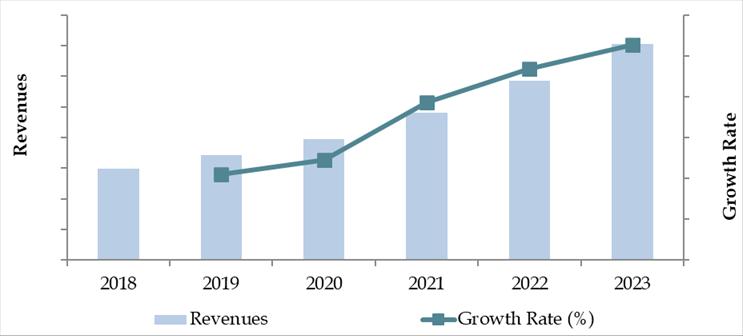
What Factors are Leading to the Growth of Lebanon Cold Chain Market:
Pharmaceutical Sector Expansion: Lebanon’s pharmaceutical imports grew by 15% in 2023, requiring advanced cold chain systems for storage and distribution. Cold chain logistics ensures the efficacy and safety of temperature-sensitive vaccines and medicines.
Growth in Perishable Food Trade: Demand for imported dairy, meat, and seafood products is rising. Retail chains and HORECA (Hotel/Restaurant/Catering) players increasingly rely on cold chain logistics to maintain product quality. Chilled and frozen food demand increased by 12% YOY in 2023.
Regulatory Compliance and Safety: The Lebanese Ministry of Health and Ministry of Agriculture have strengthened regulations around perishable goods handling. Cold chain providers must now adhere to stricter audit and compliance standards, encouraging modernization.
Which Industry Challenges Have Impacted the Growth for Lebanon Cold Chain Market
Infrastructure Gaps and Power Outages: A significant challenge for the Lebanese cold chain market is the inadequate infrastructure, particularly in warehousing and transport systems. Frequent electricity outages and lack of reliable cold storage facilities have led to high spoilage rates. According to industry estimates, up to 25% of perishable goods are lost annually due to cold chain failures. This severely limits the scalability and reliability of cold chain services in the country.
High Operational Costs: The cost of maintaining cold storage and temperature-controlled logistics is elevated due to Lebanon’s reliance on imported fuel and energy. In 2023, energy costs contributed to over 30% of total cold chain logistics expenses, significantly higher than the regional average. This discourages small and mid-sized businesses from investing in cold chain solutions, particularly outside Beirut and Tripoli.
Limited Skilled Workforce: The cold chain industry in Lebanon faces a shortage of trained technicians, warehouse managers, and logistics coordinators specialized in temperature-sensitive operations. This workforce gap limits the quality of service and slows the adoption of new technologies. A 2023 industry survey indicated that over 40% of companies report difficulty in recruiting skilled cold chain personnel.
What are the Regulations and Initiatives which have Governed the Market
Food Safety and Hygiene Regulations: Lebanon’s Ministry of Public Health (MoPH) enforces food safety laws that require businesses dealing with perishable food to comply with specific cold storage and transportation standards. These regulations became stricter post-2021, after public scrutiny over food safety incidents. By 2023, over 65% of inspected facilities met compliance standards, a marked improvement from 40% in 2020.
Pharmaceutical Transport Compliance: The Ministry of Public Health also mandates Good Distribution Practices (GDP) for pharmaceuticals, including mandatory cold storage during transit for temperature-sensitive drugs. As of 2023, GDP certification is required for all distributors handling vaccines and biologics, significantly impacting investment in compliant refrigerated vehicles and warehouse systems.
International Aid and Private Sector Investment: Several initiatives supported by UN agencies and European donors have been launched to build cold chain infrastructure for vaccine and food supply in Lebanon. In 2023, a joint EU-funded program helped establish 12 modernized cold storage facilities in underserved regions, improving last-mile delivery capacity and reducing regional inequality in access to cold chain logistics.
Lebanon Cold Chain Market Segmentation
By Market Structure: The Lebanon cold chain market is primarily dominated by unorganized players, especially in the food segment, where local distributors and small cold storage operators handle the majority of operations. These entities rely on basic refrigeration setups and have limited technology integration. However, organized players such as Mediline Cold Chain, Transmed, and Aramex have been expanding rapidly, particularly in pharmaceuticals and high-value perishables. Organized providers offer traceability, temperature monitoring, and adherence to international standards—making them preferred partners for multinational clients.
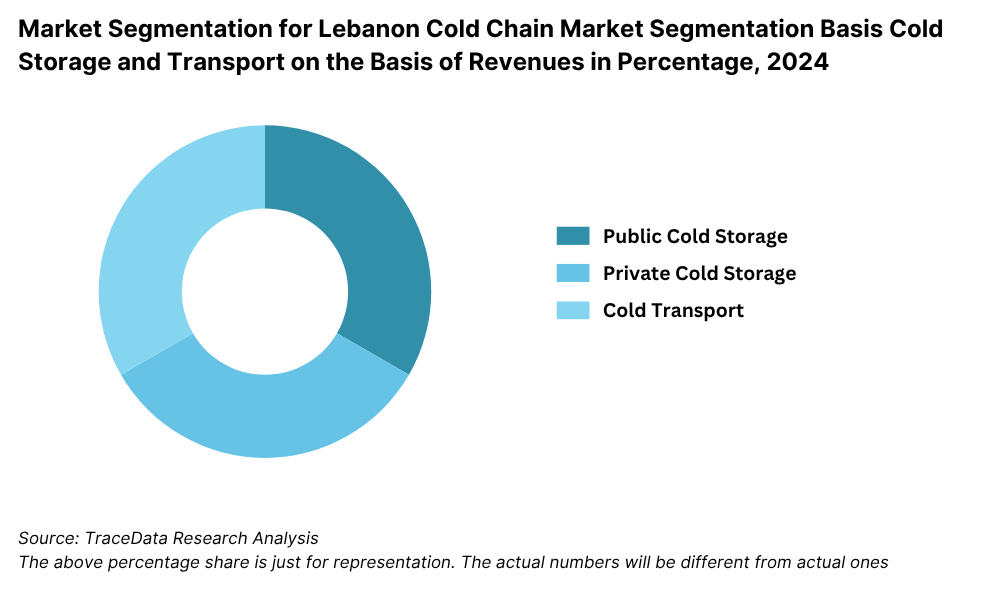
By Type of Product: The cold chain market in Lebanon can be segmented into perishables (fruits, vegetables, dairy, seafood, and meat) and pharmaceuticals. Perishables dominate due to Lebanon’s high reliance on food imports and exports, particularly to Gulf countries. Nonetheless, the pharmaceutical segment is growing at a faster pace owing to increased regulation and demand for temperature-controlled storage for vaccines, insulin, and specialty drugs.
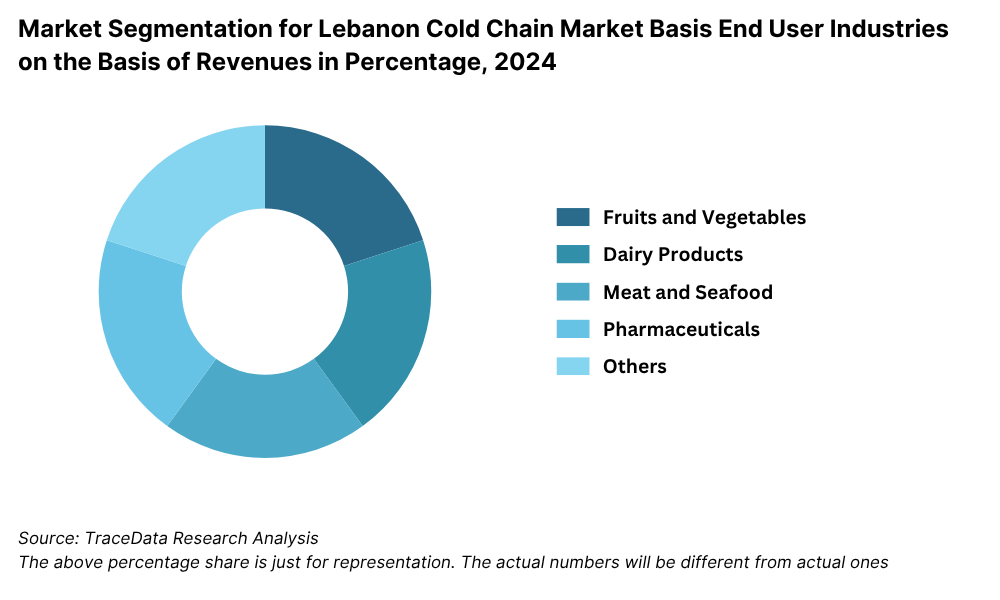
By Temperature Type: The cold chain infrastructure in Lebanon is split between chilled (0°C to 8°C) and frozen (< -18°C) storage and logistics. Chilled storage is more prevalent due to the dominance of dairy, fruits, and vegetables, which require less extreme temperature settings. However, frozen segment demand is growing, especially for seafood, meat, and frozen food products which are increasingly being imported.
Competitive Landscape in Lebanon Cold Chain Market
The Lebanon cold chain market is moderately fragmented, with a mix of established logistics firms, regional cold storage operators, and international players. In recent years, there has been a noticeable rise in organized service providers, especially in pharmaceutical logistics and export-driven perishable goods. Companies such as Mediline Cold Chain, Aramex, Transmed, Kuehne + Nagel, and DHL Supply Chain are among the prominent names, offering integrated cold storage and transport solutions with end-to-end temperature tracking and compliance.
| Company Name | Founding Year | Original Headquarters |
| Transmed SAL (Cold Chain Distribution) | 1946 | Beirut, Lebanon |
| Daccache Group (Cold Storage & Logistics) | 1957 | Beirut, Lebanon |
| Chellaram Shipping & Logistics (Cold Chain Services) | 1970s | Beirut, Lebanon |
| G. Tamer Holding (Pharma Cold Chain) | 1922 | Beirut, Lebanon |
| Mediline Cold Chain | 2010 | Beirut, Lebanon |
| Bifarma SAL (Healthcare Logistics) | 2000 | Beirut, Lebanon |
| Speed Group SAL (Cold Storage Division) | 1995 | Beirut, Lebanon |
| Trameri (Transport Maritime et Routier) | 1975 | Beirut, Lebanon |
| DHL Global Forwarding Lebanon (Temp-Controlled) | 1969 (LB: ~1980s) | Bonn, Germany |
| DB Schenker Lebanon (Cold Chain Logistics) | 1872 (LB: ~2000s) | Essen, Germany |
| Kuehne + Nagel Lebanon (Pharma Chain) | 1890 (LB: ~1990s) | Schindellegi, Switzerland |
| Agility Logistics Lebanon | 1979 (LB: ~2000s) | Kuwait City, Kuwait |
| UPS Lebanon (Temperature-Controlled Services) | 1907 (LB: ~1990s) | Atlanta, USA |
| FedEx Express Lebanon (Cold Chain Shipping) | 1971 (LB: ~1990s) | Memphis, USA |
| Maersk Lebanon (Cold Chain Container Solutions) | 1904 (LB: ~2000s) | Copenhagen, Denmark |
Some of the recent competitor trends and key information about competitors include:
Mediline Cold Chain: As a leading local cold chain operator, Mediline expanded its warehouse footprint by 25% in 2023 and introduced IoT-based temperature monitoring systems. The company currently services over 200 pharma and food clients, including UNICEF’s regional vaccine storage program.
Aramex: Known for its robust Middle East logistics network, Aramex saw a 20% growth in temperature-controlled pharma shipments in Lebanon in 2023. Their specialized healthcare logistics division has gained traction due to compliance with GDP and WHO standards.
Transmed: Originally a food distributor, Transmed has increasingly invested in temperature-controlled logistics. In 2023, it launched a dedicated cold storage hub in the Bekaa Valley, targeting the agricultural produce export market.
Kuehne + Nagel: The global logistics player enhanced its presence in Lebanon by partnering with local cold chain providers to expand pharma and food-grade storage. Their Lebanon office reported a 15% increase in reefer container volumes in 2023.
DHL Supply Chain: Leveraging its global expertise, DHL has focused on pharmaceutical supply chains and vaccine logistics in Lebanon. In 2023, the company piloted drone-assisted temperature-sensitive deliveries in rural Bekaa and South Lebanon.
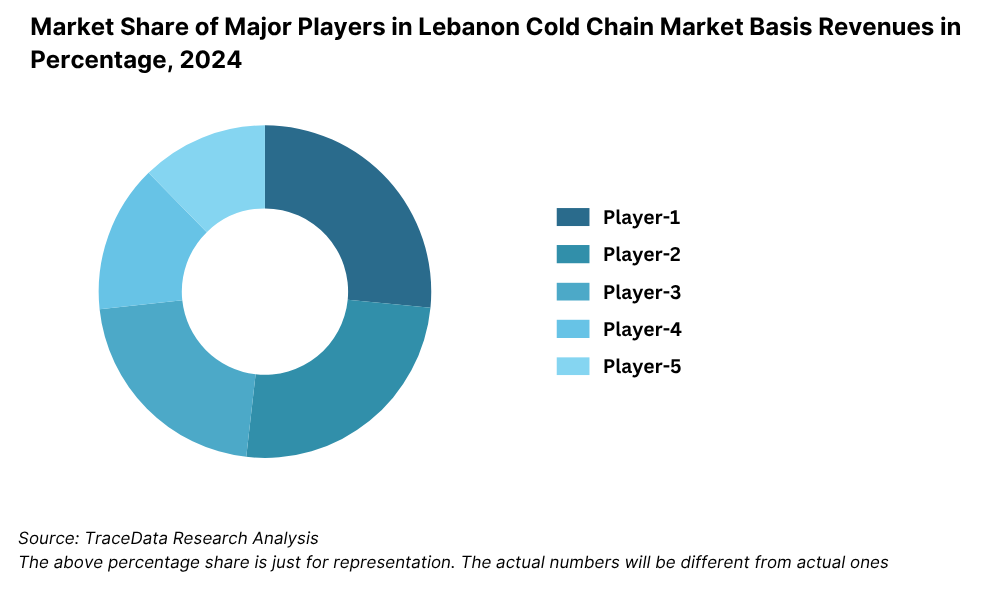
What Lies Ahead for Lebanon Cold Chain Market?
The Lebanon cold chain market is expected to witness moderate but consistent growth through 2029, driven by rising demand for perishable food exports, expansion of pharmaceutical supply chains, and improving infrastructure through donor-led investments and private sector innovation. The market is projected to grow at a CAGR of around 6-8% during the forecast period, despite challenges related to power supply and economic instability.
Expansion of Pharmaceutical Cold Chain: With increasing healthcare needs and a growing emphasis on vaccine and biologics distribution, the pharmaceutical cold chain segment is expected to grow rapidly. Government enforcement of GDP (Good Distribution Practice) compliance and partnerships with global pharma firms will fuel this expansion.
Growth in Agricultural Exports: Lebanon's high-quality produce—such as cherries, citrus, and grapes—has seen increased export demand, particularly from Gulf markets. The development of cold storage hubs in agricultural regions like the Bekaa Valley is anticipated to reduce wastage and improve shelf life, directly boosting export volumes.
Digitalization and IoT Integration: Adoption of IoT-based temperature tracking, GPS-enabled reefer logistics, and digital inventory systems is expected to increase, enhancing real-time visibility and compliance. These innovations will reduce losses and optimize logistics, attracting new clients across food and pharma sectors.
Public-Private Partnerships and Donor Investment: International development agencies and NGOs are likely to continue investing in cold chain infrastructure, particularly for food safety and public health logistics. Projects such as UNICEF’s vaccine storage program and EU-funded cold storage networks are creating long-term capacity that supports sustainable industry growth.
Future Outlook and Projections for Lebanon Cold Chain Market on the Basis of Revenues in USD Million, 2024-2029
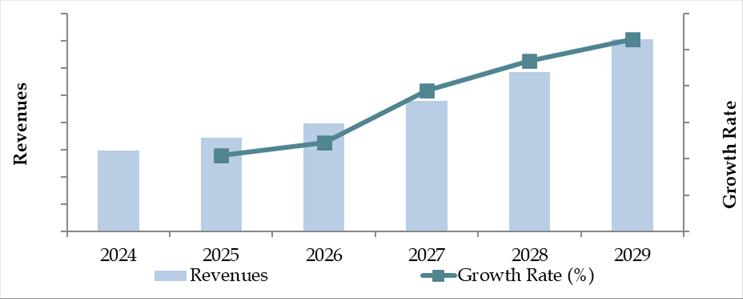

Lebanon Cold Chain Market Segmentation
• By Market Structure:
o Independent Cold Storage Operators
o Integrated 3PL Cold Chain Providers
o Temperature-Controlled Transport Companies
o Food Processing Supply Chains
o Pharma-Grade Cold Chain Providers
o Organized Sector
o Unorganized Sector
• By Type of Product:
o Fruits and Vegetables
o Dairy Products
o Meat and Seafood
o Frozen Foods
o Pharmaceuticals (Vaccines, Biologics, Insulin)
o Bakery and Confectionery
• By Temperature Type:
o Chilled (0°C to 8°C)
o Frozen (-18°C and below)
• By End-User Industry:
o Food and Beverage
o Retail Chains and Supermarkets
o Hospitality and HORECA
o Pharmaceutical and Healthcare
o Agricultural Exporters
o Government and Aid Agencies
• By Region:
o Beirut
o Mount Lebanon
o Bekaa Valley
o North Lebanon
o South Lebanon
Players Mentioned in the Report:
- NewCold
- Agility Cold Chain (Agility 3PL Lebanon)
- Excel Logistics (Fattal Group)
- SEKO Logistics Lebanon
- La Levantine "Daher & Cie"
- DHL Global Forwarding (cold chain services)
- Kuehne + Nagel Lebanon (cold logistics)
Key Target Audience:
• Cold Storage and Logistics Companies
• Perishable Food Exporters
• Pharmaceutical Distributors
• Supermarkets and HORECA Chains
• Government and Regulatory Bodies (e.g., Ministry of Public Health, Ministry of Agriculture)
• Development Agencies and NGOs
• Technology Providers for Cold Chain Infrastructure
Time Period:
• Historical Period: 2018-2023
• Base Year: 2024
• Forecast Period: 2024-2029
Report Coverage
Choose individual sections to purchase. Mix and match as you like.
- -
- -
- $250
- $100
- $250
6.1. Revenues, 2018-2024P
$3007.1. By Cold Storage and Cold Transport, 2023-2024P
7.2. By End-User Application (Dairy Products, Meat and Seafood, Pharmaceuticals, Fruits and Vegetables and Others), 2023-2024P
7.3. By Ownership (Owned and 3PL Cold Chain Facilities), 2023-2024P
$400- $100
- $200
10.1. Lebanon Cold Storage Market Size
10.1.1. By Revenue, 2018-2024P
10.1.2. By Number of Pallets, 2018-2024P
10.2. Lebanon Cold Storage Market Segmentation
10.2.1. By Temperature Range (Ambient, Chilled and Frozen), 2023-2024P
10.2.2. By End-User Application (Dairy Products, Meat and Seafood, Pharmaceuticals, Fruits and Vegetables and Others), 2023-2024P
10.2.3. By Major Cities, 2023-2024P
10.3. Lebanon Cold Storage Market Future Outlook and Projections, 2025-2029
10.3.1. By Temperature Range (Ambient, Chilled and Frozen), 2025-2029
10.3.2. By Major Cities, 2025-2029
$30011.1. Lebanon Cold Transport Market Size (By Revenue and Number of Reefer Trucks), 2018-2024P
11.2. Lebanon Cold Transport Market Segmentation
11.2.1. By Mode of Transportation (Land, Sea and Air), 2023-2024P
11.2.2. By Location (Domestic and International), 2023-2024P
11.3. Lebanon Cold Transport Market Future Outlook and Projections, 2025-2029
11.3.1. By Mode of Transport (Land, Sea and Air), 2025-2029
11.3.2. By Location (Domestic and International), 2025-2029
$30012.1. Trends and Developments in Lebanon Cold Chain Market
12.2. Issues and Challenges in Lebanon Cold Chain Market
12.3. Decision Making Parameters for End Users in Lebanon Cold Chain Market
12.4. SWOT Analysis of Lebanon Cold Chain Industry
12.5. Government Regulations and Associations in Lebanon Cold Chain Market
12.6. Macroeconomic Factors Impacting Lebanon Cold Chain Market
$20013.1. Parameters to be covered for Each End Users to Determine Business Potential:
13.1.1. Production Clusters
13.1.2. Market Demand, Major Products Stored, Cold Storage Companies in Guwahati catering to End Users
13.1.3. Location Preference for Each End User and their Production Plants, Preferences for Outsourcing and Captive Facility, Services Required, Facility Preferences, Decision Making Parameters
13.1.4. Cross comparison of leading end users/companies based on Headquarters, Manufacturing Plants, Products Stored, Major Products, Total Production, Cold Chain Partner, Facility Outsourced/Captive, Pallets Owned/Hired, Contact Person, Address and others
$500- $250
- $150
16.1. Competitive Landscape in Lebanon Cold Chain Market
16.2. Competition Scenario in Lebanon Cold Chain Market (Competition Stage, Major Players, Competing Parameters)
16.3. Key Metrics (Temperature Range, Pallet Position, Prices Charged, Occupancy Rate, Revenue (2023) and Employee Base) for Major Players in Lebanon Cold Chain Market
16.4. Company Profiles of Major Companies in Lebanon Cold Chain Market (Year of Establishment, Company Overview, Service Offered, USP, Warehousing Facilities, Warehousing Price, Cold Storage by location, Occupancy Rate, Major Clientele, Industries Catered, Employee Base, Temperature Range, Topline OPEX*, Revenue, Recent Developments, Future Strategies)
16.5. Strength and Weakness
16.6. Operating Model Analysis Framework
16.7. Gartner Magic Quadrant
16.8. Bowmans Strategic Clock for Competitive Advantage
$20017.1. Revenues, 2025-2029
$30018.1. By Cold Storage and Cold Transport, 2025-2029
18.2. By End-User Application (Dairy Products, Meat and Seafood, Pharmaceuticals, Fruits and Vegetables and Others), 2025-2029
18.3. By Ownership (Owned and 3PL Cold Chain Facilities), 2025-2029
18.4. Recommendation
18.5. Opportunity Analysis
$400
Research Methodology
Step 1: Ecosystem Creation
Map the ecosystem and identify all the demand side and supply side entities for Lebanon Cold Chain Market. Basis this ecosystem, we will shortlist leading 5-6 service providers in the country based upon their infrastructure capabilities, client portfolios, and service specialization (food or pharma).
Sourcing is made through industry articles, multiple secondary, and proprietary databases to perform desk research around the market to collate industry-level information.
Step 2: Desk Research
Subsequently, we engage in an exhaustive desk research process by referencing diverse secondary and proprietary databases. This approach enables us to conduct a thorough analysis of the market, aggregating industry-level insights. We delve into aspects like the cold storage capacity, number of market players, average utilization rates, temperature compliance, and other variables. We supplement this with detailed examinations of company-level data, relying on sources like press releases, donor-funded project reports, annual statements (where available), and similar documents. This process aims to construct a foundational understanding of both the market and the entities operating within it.
Step 3: Primary Research
We initiate a series of in-depth interviews with C-level executives and other stakeholders representing various Lebanon Cold Chain Market companies and end-users. This interview process serves a multi-faceted purpose: to validate market hypotheses, authenticate statistical data, and extract valuable operational and financial insights from these industry representatives. Bottom to top approach is undertaken to evaluate total storage capacity and throughput for each player thereby aggregating to the overall market.
As part of our validation strategy, our team executes disguised interviews wherein we approach each company under the guise of potential clients. This approach enables us to validate the operational and financial information shared by company executives, corroborating this data against what is available in secondary databases. These interactions also provide us with a comprehensive understanding of infrastructure type, revenue streams, process, pricing, and other factors.
Step 4: Sanity Check
- Bottom to top and top to bottom analysis along with market size modeling exercises is undertaken to assess sanity check process.
FAQs
1. What is the potential for the Lebanon Cold Chain Market?
The Lebanon cold chain market holds significant growth potential, reaching an estimated valuation of USD 420 Million in 2023. This growth is driven by rising demand in sectors such as pharmaceuticals and perishable food exports, combined with increased awareness of food safety and vaccine logistics. International investments and technological advancements are further strengthening infrastructure and operational standards, opening opportunities for scalable cold chain operations across the country.
2. Who are the Key Players in the Lebanon Cold Chain Market?
The Lebanon Cold Chain Market features several key players, including Mediline Cold Chain, Aramex, Transmed, DHL Supply Chain, and Kuehne + Nagel. These companies are recognized for their extensive infrastructure networks, adherence to global standards such as GDP for pharmaceuticals, and their growing investment in technology and regional storage hubs. Other emerging players include Barakat Cold Logistics and PharmaNet.
3. What are the Growth Drivers for the Lebanon Cold Chain Market?
Key growth drivers include the increasing need for temperature-controlled logistics in pharmaceuticals (especially for vaccines, insulin, and biologics), growing agricultural exports to Gulf countries, and the digitization of cold chain operations using IoT and real-time tracking. Additionally, donor-backed initiatives and public-private partnerships are enabling the expansion of cold storage facilities in underserved regions.
4. What are the Challenges in the Lebanon Cold Chain Market?
The Lebanon Cold Chain Market faces several challenges including frequent electricity outages, which compromise storage reliability, and high operational costs due to fuel dependence. Other obstacles include infrastructure gaps in rural areas, limited access to skilled cold chain professionals, and regulatory enforcement inconsistencies. These challenges impact scalability and service consistency across regions.